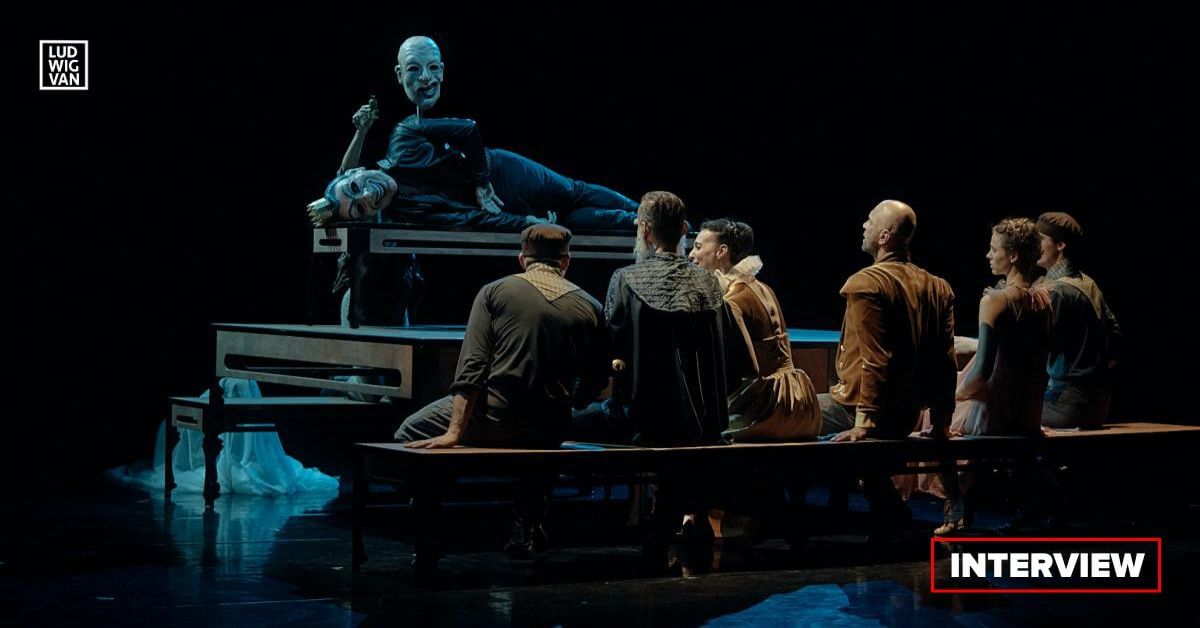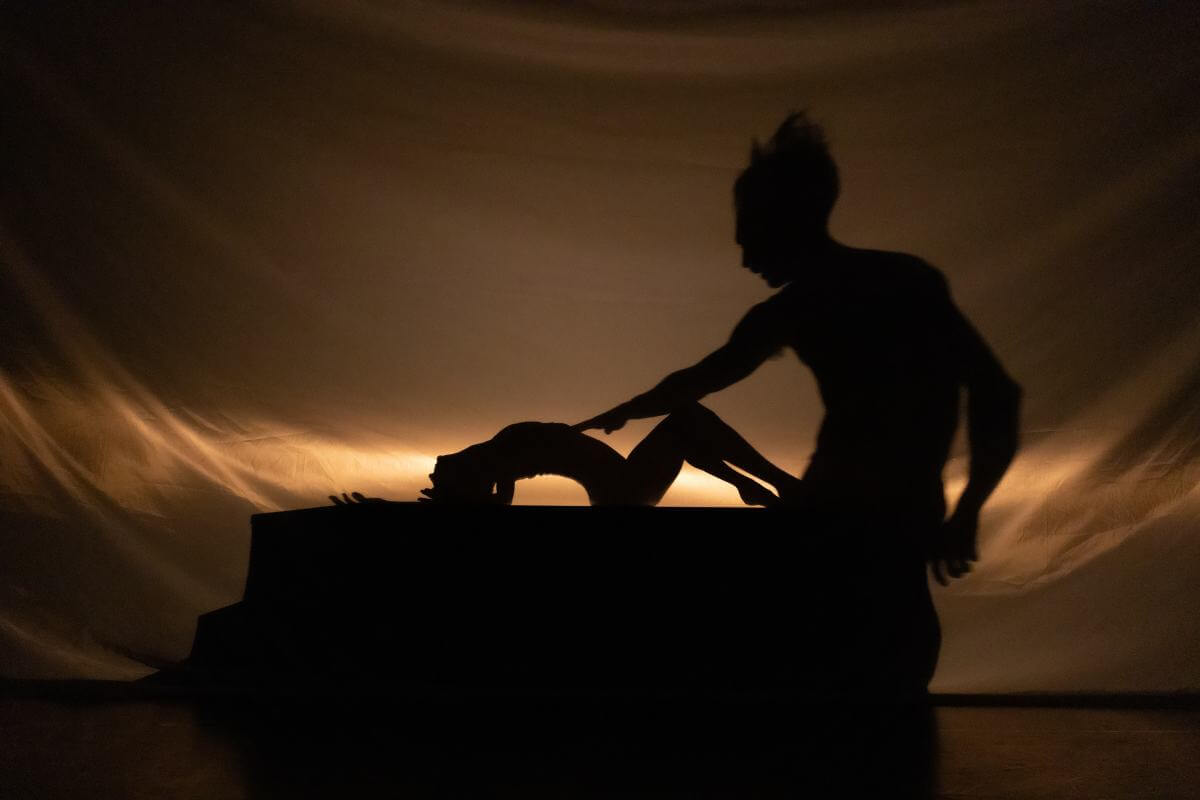
What’s the definition of a winning combination? What about Robert Lepage, Canada’s preeminent visionary man of theatre, acclaimed choreographer/dancer Guillaume Côté, and Shakespeare’s Hamlet?
Lepage and Côté have united again to create the dance theatre piece, The Tragedy of HAMLET Prince of Denmark, that makes its world premiere at the Elgin Theatre on April 3 (closing on April 7). The first time these two bright lights collaborated, their fertile minds produced the much-acclaimed Frame by Frame for the National Ballet of Canada in 2018, their brilliant homage to Canadian film innovator, Norman McLaren.
What follows is an in-depth interview with Côté about the Hamlet project, which reveals that this new dance theatre is an entirely different beast than the technology-rich Frame by Frame.
Our conversation found Côté in his car, which, apparently, is his favourite place to Zoom. Incidentally, Côté cast himself as Hamlet.

I’d like to go back to the very beginning. How did you first meet Lepage?
After I saw his brilliant production of The Nightingale and Other Short Fables that he did for the Canadian Opera Company in 2009, I started to stalk him.
In 2012, I was awarded the Médaille de l’Assemblée nationale du Québec, which brought me to Québec City. His company Ex Machina is based there, so I wrote to him at his studio, and sent him a video of my piece In Touch. Oddly, the first time we actually met in person was at a café in Toronto.
Over the years, we remained in contact, and he started to come to see my choreographies. We then began to talk about the possibility of perhaps collaborating together.
When I approached him about doing a production for the National, he was nervous about working with ballet. Then came the 400th anniversary of Québec City, and Norman McLaren was one of the featured artists. Robert saw just how much of McLaren’s work was dance-driven, which got him interested in doing a piece with me about McLaren and the National Film Board.
I approached the National’s then artistic director, Karen Kain, and she was amazing, giving us the funds for eight National dancers to do a one-week workshop at the Ex Machina studio, and lots of good ideas emerged. Over the next three years, we slowly built the piece Frame by Frame through a series of workshops.
Over time, Robert and I started to hang out together. He is so famous, yet, so humble. What a generous, sweet man he is, and of course, we started to talk about what our next collaboration could be.
And that led to Hamlet.
Robert has staged numerous productions of Hamlet worldwide, and has performed the role himself. In 2016, he even collaborated with some Russian artists to create a one-man show of the play that he directed.
I approached him about a collaboration when we were working on Frame by Frame because he knows Hamlet so well. He was excited about the play’s potential as dance theatre, as nonverbal expression.
Where was your starting point?
A creator needs to ask a lot of questions. We did research into Danish history and Elsinore, and then it was a deep dive into Shakespeare’s text. We read the play together, then we read lines to each other like actors would. Robert has a profound knowledge of the play, and we dissected every aspect of it.
For example, Claudius’ lines contain many S’s which inform his character, while Polonius’ imagery is about the eye, so he is always watching. Robert pointed out that the punctuation was not from Shakespeare’s time, so, for example, move one comma in “To be, or not to be”, and you have a different meaning.
Robert sees the play as being based on a skull — that the play is built on a human skull and a human face, and a man holding a skull. That is at the heart of the play’s structure.
But creation turned out to be a bumpy road.
Robert had a rough few years. He was accused of cultural appropriation, first for his show SLĀV, about Afro-American slavery, and then Kanata, about Indigenous people and settlers. SLĀV in Montreal was cancelled mid-run, while Kanata [had a controversial run] to the stage in Paris. Although Robert stood his ground against these woke accusations, he became gun shy about telling other people’s stories. He really wondered if we were in safe territory with Hamlet because he was a Danish prince. Instead he worked on two other productions, one about wrestling [and a circus show combined], before coming back to Hamlet.

I understand that this production is low tech, while Lepage is known for his brilliant use of technology. This is a real departure.
Robert’s approach this time was to create a piece from the bare essentials. His premise is that dance is powerful when it doesn’t have to compete with anything else. It is a theatrical narrative approach emphasizing movement.
How would you describe the dance?
The choreography itself is solely and exactly geared to tell the story. Every movement, every gesture, is charged with meaning, and taken from Shakespeare’s text. We are telling a very complicated story through both contemporary and classical dance.
We could have been abstract, which is a very up to date, modern times thing to do, which, quite frankly, is the direction that I wanted to take, but Robert convinced me to go traditional, back to Elizabethan times, back to the text, except we don’t have any words. The story is infused in the choreography, and John Gzowski’s wonderful original score underlines that physicality.
You say that the text generated movement. What do you mean?
The words themselves — Shakespeare’s images —created the dance. When you read the text, you see the dance in your head. The subtle shifts and changes of Hamlet’s mind — is his madness manipulative, or is it real — all translate into movement.
The story goes beyond the dialogue to lend itself to physical storytelling.
Let’s talk about how you and Lepage have presented the character of Hamlet.
Simply put, Hamlet is in his head, interpreted through the virtuosity of ballet. He is a man consumed by doubt, who is perhaps descending into madness after his father dies under suspicious circumstances. The dance is an expression of his inner contradictions and paradoxes. We are all faced with choices in life, whether to do right or wrong, and must always accept the consequences of our actions.
How do you see the production as a whole?
We pull the audience into a world of deception, where phantoms and humans mingle on a minimalist set. It is a metaphorical reinterpretation that connects the movement of the body with what may or may not be lurking within the corners of the mind. Hamlet remains a deep mirror to human experience, and by gaining a deeper understanding of his character, we can appreciate the importance of taking action to address the problems of humanity.

What are some of the low tech features?
There is as much choreography behind the stage as on the stage, with seven techies creating the magic. The visionary lighting is a big factor, and that is where Robert’s visual signature has really made its mark.
The dancers change the sets, turning tables into a coffin, for example, or mirrors into a hallway, so the same elements are used for different things by creating different variations. The ghost of Hamlet’s father is a bed sheet, but how it is used is a wonder. There is a simple skeleton, but the effect is thrilling. We also have some drops, and a props curtain like an old-fashioned Italian show.
It was refreshing using only the bare necessities. Also, this means we have a one-day set up, so we can tour anywhere.
Tell me about the dancers.
There are nine in all, including myself. It was important that the characters be age appropriate — so no sticking on of a beard — with the choreography adjusted to the dancers’ abilities. For example, Bernard Meney who is Polonius is 70. Robert Glumbek as Claudius is 50, and so is retired National principal dancer, Greta Hodgkinson, who is Gertrude. Laertes, on the other hand, is performed by young Lukas Malkowski who is a break dancer.
When I choreographed Frame by Frame, the dancers were unified, all from the same ballet company. With Hamlet, we have all ages and different dance styles.
What has the creation process been like?
We both work in each other’s turf, staging, directing, choreographing. I’m so grateful that the work process has been so wonderful.
What is it like to choreograph for yourself?
I suppose I gave myself the leading role because it’s my last hurrah. I’m 41, and retiring from the National next season. But Hamlet is also very difficult to dance, and I’m reminded about something that Nureyev said — that since he was making the role for himself, why did he make it so hard?
You did a performance of Hamlet last summer at Le Festival des Arts de Saint-Sauveur, where you are artistic director. How much of that production survives?
This Hamlet is a totally different show. One of the new features is that John has recorded the score instead of having live instruments. He used real musicians in the recording which features a cello, violin, guitar, a hurdy-gurdy and some electronica. It’s brilliant.
What do you want the audience to take away from this dance theatre?
That it is beautiful to see something through a different lens. That Hamlet has more than one story to tell.
* The piece was amended to correct details regarding Lepage’s other projects in the interview.
Are you looking to promote an event? Have a news tip? Need to know the best events happening this weekend? Send us a note.
#LUDWIGVAN
Get the daily arts news straight to your inbox.



